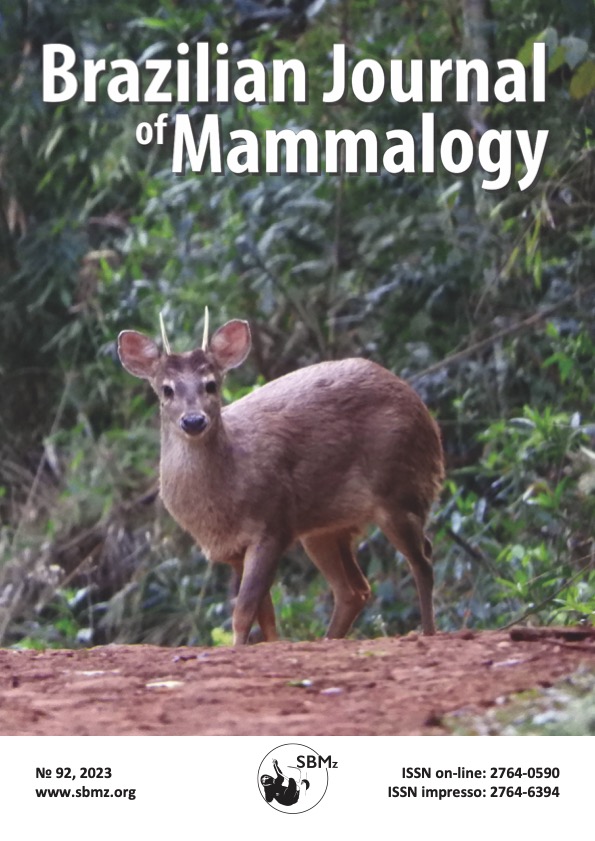Padrões de fluorescência em uma coleção de Didelphidae paraguaios
DOI:
https://doi.org/10.32673/bjm.vi92.89Palavras-chave:
Cryptonanus, Didelphidae, Didelphis, Flourescência, Lutreolina, MarmosaResumo
Many species of opossum (Didelphimorphia) are known to fluoresce, but the significance of this characteristic is unclear. In the interests of contributing to the faunal inventory of fluorescence in Didelphids, we examined 62 specimens of 10 species of Paraguayan opossums under a UV light and describe the patterns observed. Of particular interest is a clear apparent difference in fluorescence between two cryptic and occasionally sympatric species, Marmosa rapposa and Marmosa paraguayana which may be a potential isolating mechanism. Furthermore, we suggest the possibility that fluorescence declines with time since collection in Didelphis albiventris, and the fluorescence in that species is not related to age or sex. While the significance of fluorescence in Didelphids remains obscure, patterns observed show some degree of species specificity within the geographic boundaries of this study.
Referências
Anderson JE, Pine RH, Ligara T. 1978. Ultraviolet light induced fluorescence in didelphids. Abstracts Tech. Papers 58th Annual Meeting of the American Society of Mammalogists: 99.
Anich PS, Anthony S, Carlson M, Gunnelson A, Kohler AM, Martin JG, Olson ER. 2021. Biofluorescence in the platypus (Ornithorhynchus anatinus). Mammalia 85: 179-181. https://doi.org/10.1515/mammalia-2020-0027.
Arnold KE, Owens IPF, Marshall NJ. 2002. Fluorescent signaling in parrots. Science 295: 92. https://doi.org/10.1126/science.295.5552.92.
Blair WF. 1950. Ecological factors in speciation of Peromyscus. Evolution 4: 253-275.
Davies WL, Carvalho LS, Cowing JA, Beazley LD, Hunt DM, Arrese CA. 2007. Visual pigments of the platypus: a novel route to mammalian colour vision. Current Biology 17: 161-163. https://doi.org/10.1016/j.cub.2007.01.037.
Gardner AL (Ed.) 2008 (2007). Mammals of South America. Volume 1 marsupials, xenarthrans, shrews and bats. Chicago University Press, Chicago.
Gruber DF, Sparks JS. 2015. First observation of fluorescence in marine turtles. American Museum Novitates 3845: 1-8.
Hunt DM, Carvalho LS, Cowing JA, Davies WL. 2009. Evolution and spectral tuning of visual pigments in birds and mammals. Philosophical. Transactions of the Royal Society of London B 364: 2941–2955.
Kohler AM, Olson ER, Martin JG, Anich PS. 2019. Ultraviolet fluorescence discovered in New World flying squirrels (Glaucomys). Journal of Mammalogy 100: 21-30. https://doi.org/10.1093/jmammal/gyy177.
Meisner DH. 1983. Psychedelic opossums: fluorescence of the skin and fur of Didelphis virginiana Kerr. The Ohio Journal of Science 83: 4.
Olofsson M, Vallin A, Jakobsson S, Wiklund C. 2010. Marginal eyespots on butterfly wings deflect bird attacks under low light intensities with UV wavelengths. PLoS One 5: e10798. https://doi.org/10.1371/journal.pone.0010798.
Olson ER, Carlson MR, Sadagopa Ramanujam VM, Sears L, Anthony SE, Spaeth Anich P, Ramon L, Hulstrand A, et al. 2020. Vivid biofluorescence discovered in the nocturnal Springhare (Pedetidae). Nature Scientific Reports 11: 4125. https://doi.org/10.1038/s41598-021-83588-0.
Pine RH. 1978. Notes on the Brazilian opossum Monodelphis scalops (Thomas) (Mammalia: Marsupialia: Didelphidae). Mammalia 42(3): 379-382.
Pine RH. 1979. Taxonomic notes on 'Monodelphis dimidiata itatiayae (Miranda-Ribeiro)'; Monodelphis domestica (Wagner) and Monodelphis maraxina Thomas (Mammalia: Marsupialia: Didelphidae). Mammalia 43(4): 495-499. https://doi.org/10.1515/mamm.1979.43.4.495.
Pine RH. 1981. Reviews of the mouse opossums Marmosa parvidens Täte and Marmosa invicta Goldman (Mammalia: Marsupialia: Didelphidae) with description of a new species. Mammalia 45(1): 56-70. https://doi.org/10.1515/mamm.1981.45.1.55
Pine RH, Handley Jr CO. 1984. A review of the Amazonian short-tailed opossum Monodelphis emiliae (Thomas). Mammalia 48(2): 239-245. https://doi.org/10.1515/mamm.1984.48.2.239.
Pine RH, Rice JE, Bucher JE, Tank Jr DJ, Greenhall AM. 1985. Labile pigments and fluorescent pelage in didelphid marsupials. Mammalia 49: 249-256. https://doi.org/10.1515/mamm.1985.49.2.249.
Smith P, Owen RD. 2015. The subgenus Micoureus (Didelphidae: Marmosa) in Paraguay: Morphometrics, distributions, and habitat associations. Mammalia 79: 463-471. https://doi.org/10.1515/mammalia-2014-0050.
Smith P, Owen RD. 2016. Marmosa constantiae (Didelphimorphia: Didelphidae). Mammalian Species 48(941): 123-129. https://doi.org/10.1093/mspecies/sew012.
Snyder HK, Maia R, D’Alba L, Shultz AJ, Rowe KMC, Rowe KC, Shawkey MD. 2012. Iridescent colour production in hairs of blind golden moles (Chrysochloridae). Biology Letters 8(3): 393-396. https://doi.org/10.1098/rsbl.2011.1168.
Sobral G, Souza-Gudinho F. 2022. Fluorescence and UV-visible reflectance in the fur of several Rodentia genera. Scientific Reports 12: 12293. https://doi.org/10.1038/s41598-022-15952-7.
Voss RS. 2022. An annotated checklist of recent opossums. Bulletin of the American Museum of Natural History 455: 1-74. https://doi.org/10.1206/0003-0090.455.1.1.
Voss RS, Gutiérrez EE, Solari S, Rossi RV, Jansa SA. 2014. Phylogenetic relationships of mouse opossums (Didelphidae, Marmosa) with a revised subgeneric classification and notes on sympatric diversity. American Museum Novitates 3817: 1-27.
Weidensaul CS, Colvin BA, Brinker DF, Huy JS. 2011. Use of ultraviolet light as an aid in age classification of owls. Wilson Journal of Ornithology 123: 373–377.
Downloads
Publicado
Como Citar
Edição
Seção
Licença
Copyright (c) 2024 Brazilian Journal of Mammalogy

Este trabalho está licenciado sob uma licença Creative Commons Attribution 4.0 International License.


